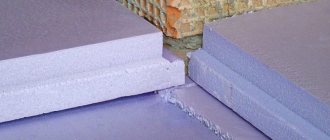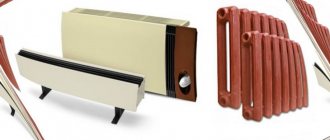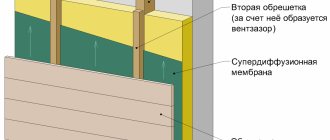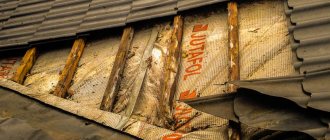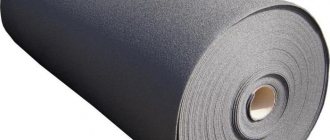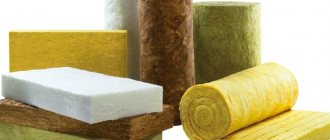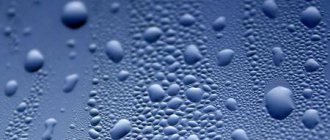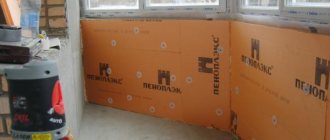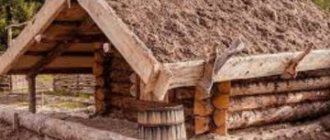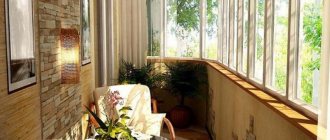How to fix polystyrene foam to a brick wall, we wrote in a previous publication. Now let's talk about facade insulation.
Have you built a house, but there is no heat in it, or utility bills for a cramped apartment at the mansion level? Then it's time to think about the thermal insulation of your home! Most of the domestic housing stock is Soviet-era buildings, when few people thought about insulation, and most of the materials left the construction site without being installed. Modern technologies make it possible to insulate the finished building, it remains only to decide on the material! Insulation for the walls of the house, inside and outside: which one is better to choose? Let's figure it out together!
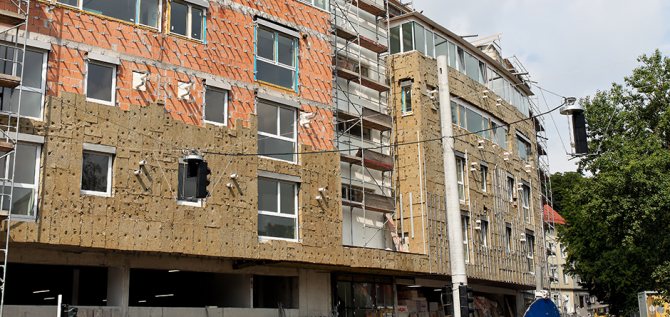
We compare and select materials for thermal insulation of houses
The differences and similarities of thermal insulation products should be considered in the context of the following characteristics:
1. Strength. The strength indicators of the material for the insulation of facades directly depend on its density:
- for the arrangement of external walls, polystyrene foam is used with a density of 16.0 to 18.5 kg / cu. meter, plate thickness - from 80 mm, 100 mm. Regulated compressive strength at 10% linear deformation not less than 100 kPa, ultimate strength in bending not less than 180 kPa, ultimate tensile strength in the direction perpendicular to the surface not less than 100 kPa
- tensile strength perpendicular to the front surfaces more than 15 kPa. The issue of choosing mineral wool for arranging external walls is solved as follows: if a ventilated facade is installed, then slabs with a density of 45-100 kg / cubic meter are used. meter; for the "wet" facade system - 145-165 kg / cu. meter.
2. Water vapor permeability. If, apart from a specific facade system, we compare that it is better to pass steam through mineral wool or foam plastic, then mineral wool slabs will benefit. The vapor permeability coefficient of foam is at least 0.05 mg / m * h * Pa, while for mineral wool it is 6 times higher. But if the wall outside is finished with synthetic coatings, then the characteristics of the mineral wool deteriorate sharply due to the inability to remove condensate outside. In combination with plasters with a high vapor permeability index - silicone and silicate-silicone, it is optimal to use mineral wool boards in combination with plaster mixtures with a high vapor permeability index - silicone and silicate-silicone compounds.
3. Heat resistance. If we approach the choice of heat-insulating materials from the standpoint of assessing the level of thermal conductivity, then these values for stone wool and PPS are approximately equal. Mineral wool - no more than 0.0475 W / mK, PPS - no more than 0.041 W / mK.
4. Resistance to fire. The materials used for insulating facades should be classified as non-combustible or low-combustible raw materials. Basalt fibers, of which the mineral wool slab is composed, melt at temperatures above 1000 degrees Celsius, therefore, the insulation based on them is highly resistant to fire. PPS burns at a temperature of 110-120 degrees. It is subdivided into classes - G (combustible), G1-G4 weak and highly combustible products, respectively.
5. Load on supporting structures. The optimal choice of wall insulation depends on the materials correctly selected by weight. Expanded polystyrene is 3-4 times lighter than mineral wool board
Another important indicator for comparison is durability. The service life of mineral wool insulation is 20-40 years. Polyfoam is also characterized by high reliability, but a slightly shorter service life.The use of vapor barrier and waterproof layers in facade systems increases the operational period at times.
What is the difference between vapor barrier and vapor-permeable films
More and more people in the modern world are thinking about moving to a country house. The advantages of such housing are obvious: remoteness from the bustle of the city and noise, clean air, proximity to nature, the ability to independently plan architecture and design, avoidance of housing and communal services problems, etc. So, you have made the decision to build a country house. The problems of developing a house project, design and decoration, and, of course, the procurement of building and finishing materials arise.
The most necessary finishing materials include insulation, vapor barrier and vapor-permeable films.
The insulation is protected from two sides, and the materials used from different sides have completely different purposes. In order for the steam that is formed during the life of a person inside his home, does not get into the insulation and does not damage it, a vapor barrier is used. And, on the contrary, in order to release steam from the insulation and not allow moisture to pass into it, a vapor-permeable membrane is used from the outside. In addition, the vapor-permeable membrane serves to protect lightweight insulation from blowing and the removal of mineral fibers from them.
To choose a material for a vapor barrier and a vapor-permeable membrane, you need to know what these indicators mean:
- Water vapor permeability. The vapor permeability index determines how many grams of moisture in the form of vapor can pass through the material per day. For a vapor barrier, this indicator can range from several to tens of grams; for a vapor-permeable membrane, it is calculated in hundreds or thousands of grams.
- Durability. This mounting characteristic indicates the quality of the material and is important for both protections. A membrane with good strength is able to withstand the tests of snow and wind, the roof covered with it can be left for the winter without the roofing itself.
- Water column pressure. It is a measure of the material's ability to hold the weight of water. A foil with this high value can serve as a temporary roof.
- UV resistance. This indicator must be taken into account if the material will be for a long period without inner filing or roofing, under the influence of sunlight.
- Mount. There are different ways of fastening: through wooden slats, staple staples, roofing nails.
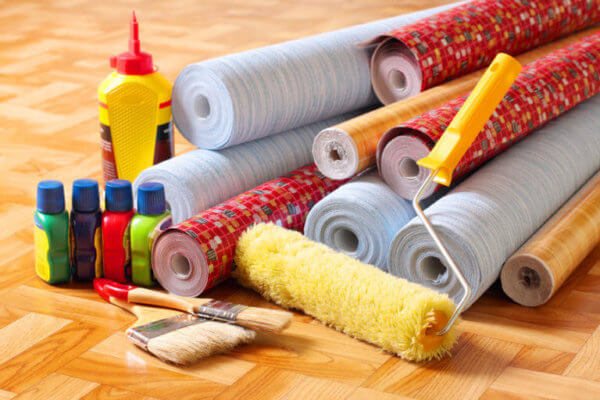

The products of different manufacturers may differ in chemical composition, therefore, when joining panels, it is advisable to use an adhesive tape and a membrane from the same company.
- Cost. It is necessary to determine the total cost of the membrane not so much by the cost of the roll as by the cost of 1 square meter.
Knowing all of the above will help you make the right choice when buying finishing materials.
Choosing insulation for your home: description, advantages and disadvantages
Differences in performance and structure of products are due to the use of different production technologies and materials:
- Stone wool is produced by melting dolomite and basalt rocks. By heating them to a temperature of 1200-1600 degrees Celsius, a viscous mass is obtained, from which thin fibers are drawn, formed into plates, and pressed. The final stage - the finished product is subjected to high-temperature processing. The fibers in the sheets are vertically and horizontally oriented, and can also be randomly arranged. This material, used in house insulation, has low thermal conductivity, good sound insulation and resistance to deformation. Due to the high vapor permeability, the walls "breathe" and thereby maintain a favorable microclimate in the house.
- Expanded polystyrene is made using the technology of foaming and subsequent soldering of polystyrene balls. The expanded polystyrene mass obtained in this way is pressed into plates, which are then cut to specified dimensions. The result is a product with high thermal efficiency and excellent water resistance. Also important characteristics of foam are light weight, ease of processing and installation, resistance to deformation.
The disadvantages of insulation based on expanded polystyrene include low resistance to open fire. The use of various fire retardants in the manufacturing process somewhat eliminates this problem. Also, to the disadvantages of the material, we add a small coefficient of vapor permeability, instability to organic solvents, low sound insulation properties.
Mineral wool has two drawbacks - high weight and relatively high cost compared to PPP.
Vapor-permeable walls, are they needed
First of all, it must be said that about vapor-permeable (breathable) and vapor-permeable (non-breathable) walls, I will not argue in terms of good / bad, but I will consider them as two alternative options. Each of these options is perfectly correct if performed with all the required requirements. That is, I am not answering the question “do we need vapor-permeable walls”, but I am considering both options.
So, vapor-permeable walls breathe, let air (vapor) pass through themselves, and vapor-permeable walls do not breathe, do not let air (vapor) pass through themselves. The vapor-permeable walls are made only of vapor-permeable materials. Vapor-NON-permeable walls contain at least one layer of vapor-NON-permeable material in their structure (this is enough for the entire wall as a whole to become vapor-NON-permeable). All materials are divided into vapor-permeable and vapor-NON-permeable, this is not good, not bad - this is such a given :-).
Now let's see what all this means when these walls are included in a real house (apartment). We do not consider the design possibilities of vapor-permeable and vapor-permeable walls in this matter. Both such and such a wall can be made strong, rigid, and so on. The main differences are obtained in the following two issues:
Heat loss. Naturally, additional heat loss occurs through the vapor-permeable walls (heat also escapes with the air). I must say that these heat losses are very small (5-7% of the total). Their size affects the thickness of the thermal insulation and the heating power. When calculating the thickness (wall, if it is without insulation, or the insulation itself), the vapor permeability coefficient is taken into account. When calculating heat loss for the selection of heating, heat loss due to the vapor permeability of the walls is also taken into account. That is, these losses are not lost anywhere, they are taken into account when calculating what they affect. And, moreover, we have already done enough of such calculations (for the thickness of the insulation and heat loss for calculating the heating power), and this is what you can see: there is a difference in numbers, but it is so small that it cannot really affect either the thickness of the insulation or the power of the heater. Let me explain: if with a vapor-permeable wall you need, for example, 43 mm of insulation, and with a vapor-permeable wall - 42 mm, then this is still 50 mm, in both versions. The same is with the boiler power, if in terms of overall heat loss, it is clear that a 24 kW boiler is needed, for example, only because of the vapor permeability of the walls, the next boiler in power will not work.
Ventilation. Vapor-permeable walls participate in air exchange in the room, and vapor-permeable walls do not. There must be an inflow and an exhaust in the room, they must correspond to the norm and be approximately equal. In order to understand how much inflow and exhaust should be in the house / apartment (in m3 per hour), a ventilation calculation is made.It takes into account all the possibilities of inflow and exhaust, the norm for this house / apartment is considered, the realities and the norm are compared, and methods of bringing the inflow and exhaust power to the norm are recommended. So this is what happens as a result of these calculations (we have already done a lot of them too): as a rule, there is not enough inflow in modern houses. This is because modern windows are vapor tight. Previously, no one considered this ventilation for private housing, since the inflow was normally provided by old wooden windows, leaking doors, walls with cracks, and so on. And now, if we take new construction, so almost all houses with plastic windows, and at least half with vapor-impermeable walls. And there is practically no air flow in such houses (constant). Here, you can see examples of calculations for ventilation, in the topics:
Insulation of the walls of the house from shell rock
House with foam block walls
Specifically, these houses show that the inflow through the walls (if they are vapor-permeable) will be only about 1/5 of the required inflow. That is, ventilation should be properly designed (counted) for anyone, no matter what the walls and windows would be. Only vapor-permeable walls, and that's it, still do not provide the required inflow.
Sometimes the question of vapor permeability of walls becomes relevant in such a situation. In an old house / apartment, which lived normally with vapor-permeable walls, old wooden windows, and with one exhaust duct in the kitchen, they begin to change the windows (to plastic ones), then, for example, the walls are insulated with foam plastic (outside, as expected). Wet walls, mold and so on begin. The ventilation has stopped working. There is no inflow, the hood does not work without the inflow. From here, as it seems to me, the myth arose about the "terrible foam", which, as soon as the wall is insulated, mold will immediately begin. And the point here is in the complex of questions on ventilation and insulation, and not in the "horror" of this or that material.
Regarding what you write "it is impossible to make hermetic walls." This is not entirely true. You can completely make them (with a certain approximation to tightness), and they are made. We are currently preparing an article about such houses, where completely sealed windows / walls / doors, all air is supplied through the recuperation system, and so on. This is the principle of the so-called "passive" houses, we will talk about this soon.
Thus, here is the conclusion: you can choose both a vapor-permeable wall and a vapor-permeable wall. The main thing is to competently solve all related issues: on the correct thermal insulation and compensation for heat loss, and on ventilation.
Using heaters for the facade: choosing thermal insulation
Based on the information received, we can conclude: mineral wool and polystyrene have a number of key advantages, according to which any of these materials is suitable for arranging Ceresit plaster facades. Which insulation to choose depends more on the financial capabilities and aesthetic considerations of homeowners. Both materials can be effectively used for thermal insulation of buildings made of bricks, foam blocks and aerated concrete.
If you professionally approach wall insulation in a house with mineral wool or PPP, then the front part of the building will retain its presentable appearance for a long time. To increase the service life of the Ceresit plaster facade, it is necessary to equip a waterproofing layer and a vapor barrier.
Disadvantages of thermal insulation based on foamed polymers
Polyethylene foam
These materials are manufactured under different names, but their performance characteristics are very similar. As a rule, the closed-cell structure of extruded polystyrene foam, the price of which on the website of our company will certainly please you, improves moisture and frost resistance, but at the same time creates an impenetrable barrier for water vapor. Both with internal and external insulation, there are negative phenomena.
- In the first case, this is a significant discomfort of living due to the appearance of the "thermos effect". Due to the lack of gas and steam exchange through building structures, the air in living quarters is waterlogged to an uncomfortable level: there is a significant deterioration in people's well-being and a decrease in working capacity.
- Such insulation, which has undergone thorough testing in the Scandinavian countries, can be used if there is a central air conditioner or constantly effective ventilation.
Attention! The option of external insulation also has no particular advantages, since condensate moisture, having no outlet, accumulates inside walls and ceilings: damp walls shorten the service life of the interior decor and are more susceptible to destructive factors.
The problem of removing condensate is solved in several ways, of which the most effective is the arrangement of slot ventilation, which ensures a constant flow of air through special openings. Such a design cannot but affect the complexity of the insulation system and its cost - naturally, upward.
Only high-quality insulation will save you from bad weather - we will help you with this!


Disputes over vapor barrier
Some debate is still going on over the need for vapor control, but the consensus is getting closer. Most professionals now agree that vapor barriers are important under certain conditions, and not required for every home. In environments where conditions inside a home or office are very different from outside conditions, water vapor is likely to move through wall cavities and may be trapped inside, in which case a well-installed vapor barrier is recommended. Vapor barrier may also be required in some areas where humidity levels are particularly high.
Vapor barrier fixing rules
You can attach the film to walls, ceilings or floors using a stapler or nails with a wide head. But the best option would be to use counter rails.
The vapor barrier film should be laid with an overlap of at least 10 cm. After fastening the vapor barrier, the joints should be glued with a special tape or tape.
Membranes will help for the qualitative ratio of moisture and temperature of the building structure, as well as for a long service life. It is impossible to achieve such qualities without their participation. When laying a vapor barrier, all rules must be followed. Many manufacturers indicate on the packaging recommendations for installing a vapor barrier.

